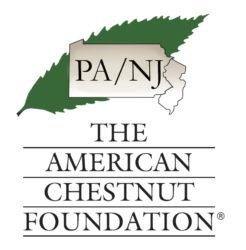Researchers would prefer to be absolutely certain that a tree has the qualities of an American chestnut that made it such an ecologically and economically important species. Those qualities include fast growth, tall height attainment, nut production, and timber value. However, most of those traits cannot be directly observed unless one waits for 60 – 100+ years! That would certainly increase the breeding time between generations!
To decrease the amount of time involved between selection and breeding, TACF scientists use various characteristics which are hoped to be highly correlated with American character and the high value traits mentioned above.
In most cases, trees in TACF breeding orchards are first selected for resistance and then selected for “American character”. Though it is important to restore native species for a variety of reasons, perhaps the most important reason TACF emphasizes these traits is so that the resulting population will be “ecologically competent”, i.e. be able to survive and perpetuate the population on its own. With the exception of blight-susceptibility, the American chestnut was a dominant species. As such, much effort is expended upon restoring the traits that made the species such a success in the forests of the Appalachian Mountains.
Depending on the type of research being conducted within a given orchard, various characteristics may be observed and selected on.
For example, in most of TACFs Regional Adaptability orchards (link to regional adaptability page), trees are selected for American character using a suite of about 15 traits that are common to American chestnuts. These traits include canoe leaf shape, absence of leaf hairs on the underside of the leaf, red twig color with small lenticels, apical dominance and others.
In other orchards, such as those that are a part of the F1, F2, F3 breeding program (link to that page), traits of interest are mainly geared toward selection of “timber type”. As such, traits such as apical dominance and form are more closely scrutinized.
More information on the differences in morphological traits between the various chestnut species may be found here: http://sfr.psu.edu/public/chestnut/breeding/identification
